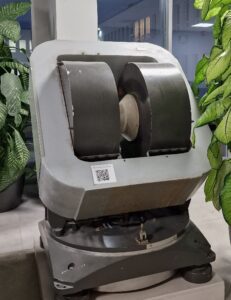Manufacturer – The Center of Scientific Instruments of the Academy of Sciences (DDR)
Magnetic field – max 1.3 T
Pole distance – 60 mm
Pole diameter – 200 mm

This magnet was purchased in a set with the East German EPR spectrometer ERS 230, which was installed in the physics sector of the Institute of Cybernetics in 1978. The ERS 230 spectrometer allowed recording EPR spectra with magnetic field scanning in both the X (9.5 GHz) and Q (34 GHz) frequency bands at magnetic field values of 0.3 T and 1.2 T, respectively.
The spectrometer was first applied to study the optical polarization of electrons produced by laser radiation in solutions of alkali metals (rubidium, cesium) and some other compounds [1]. In order to improve the sensitivity, the spectrometer was supplemented by collecting digitized spectra in the memory of the Nokia pulse analyzer LP4840. As an applied work, the dependence of the physical properties of some semiconductor materials, including the silicon oxide film, on the manufacturing technology was also investigated.
In the beginning of 1990s T. Rõõm and G. Liidja studied the relaxation of defects in CaO on this spectrometer at liquid helium temperatures [2] that resulted in the PhD dissertation of T. Rõõm.
In 1994 the research on the possibilities of EPR for personal dosimetry using tooth enamel spectra was started [3]. By collecting the signal in the memory of the NIC-1086 minicomputer and using the digital simulation of the spectra, high accuracy in radiation dose estimation was achieved [4]. The effect of ultraviolet radiation and temperature on measurement accuracy was also investigated [5,6].
The use of the spectrometer was discontinued at the end of the 90s due to the depreciation of the electronic blocks.